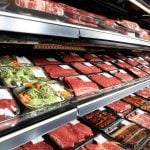By Theopolis Waters
The flow of young cattle into U.S. feedlots dropped by a smaller-than-expected two percent last month, according to a government report on Friday, a decline that analysts attributed to higher feed costs that discouraged fattening cattle for slaughter.
The U.S. Department of Agriculture on Friday reported May placements at 2.049 million head, down two percent from 2.084 million a year earlier. Analysts, on average, had expected a five percent decline.
“More cattle were moved into feedyards than expected, suggesting pasture quality wasn’t back up to snuff as some had thought,” Allendale Inc chief strategist Rich Nelson
Read Also
Canadian Financial Close: Loonie higher, TSX sets new record
Glacier FarmMedia – The Canadian dollar gained some ground on Friday and will end the week on a high note….
Prior to the report, analysts had said abundant spring rains had rejuvenated pastures and ranchers likely grazed many of their feeder cattle instead of shipping them to feedlots.
Nelson said this year’s May placements compare with much higher placements a year ago. Last year’s historic drought damaged pastures and forced cattle into feedlots.
Dan Vaught, a Doane Advisory Services economist, also attributed May’s smaller-than-anticipated placements to ranchers holding back younger cattle as their value declined.
“As much as anything else, it was the relative decline in feeder cattle prices. They were sky high a year ago and backed off quite a bit this spring,” said Vaught.
Based on Friday’s USDA report, cattle numbers could decline less than expected later this year. But that does not change the outlook for beef prices, which should remain high because of the smaller cattle supply, said analysts and economists.
Monthly government retail price data showed the average beef price in May at $5.24 per pound, down from March’s all-time high of $5.30 per lb. but up from $4.97 a year ago.
USDA on Friday put the June 1 feedlot cattle supply at 10.736 million head, or 97 percent of the year earlier. Analysts polled by Reuters, on average, expected 96.3 percent.
Also the government said the number of cattle sold to packers, or marketings, in May was down three percent from a year earlier at 1.948 million head versus the forecast for a two percent decrease.
USDA said the May marketings were the second lowest for that month since the reporting series began in 1996.
Fewer market-ready cattle reduced marketings to beef packers, even though May 2013 had the same number of marketing days as May 2012, analysts said.
The larger-than-expected placements and smaller marketings could be mildly bearish for live cattle futures early on Monday at the Chicago Mercantile Exchange, analysts said.
But, the futures’ sharp rally on Friday, stronger-than-expected cash cattle prices, and firmer wholesale beef values may offset pressure from USDA’s report.
“I don’t think the deviations are big enough to mean a whole lot to the market. We had a good week in the cattle futures,” said University of Missouri livestock economist Ron Plain.
“We (futures) may give a bit of that back on Monday but I don’t see that big of a shock from the report numbers,” he said.
Prior to the report, CME June live cattle closed up 1.300 cents on Friday at 121.250 cents per lb. and August up 1.600 at 121.600.








